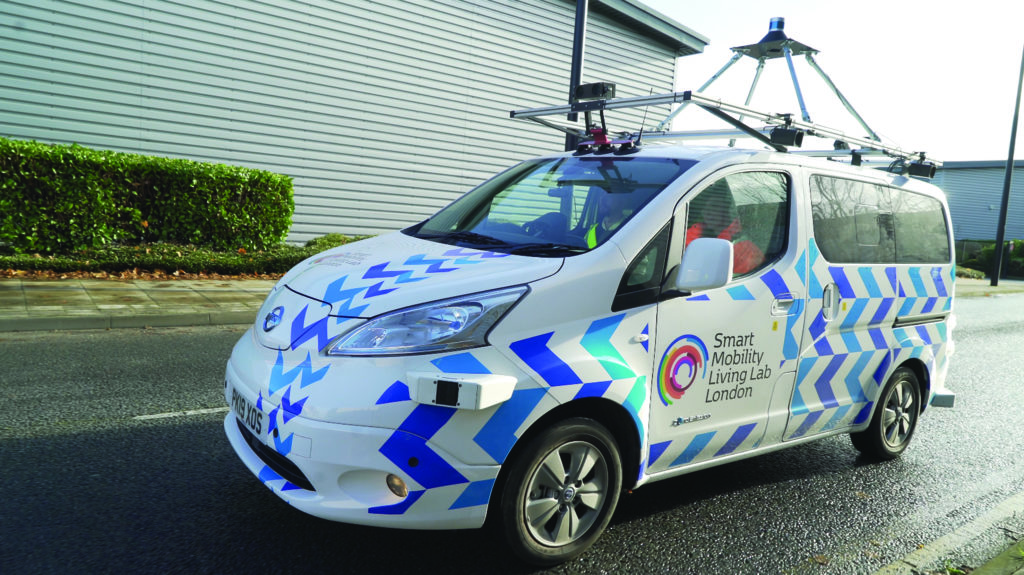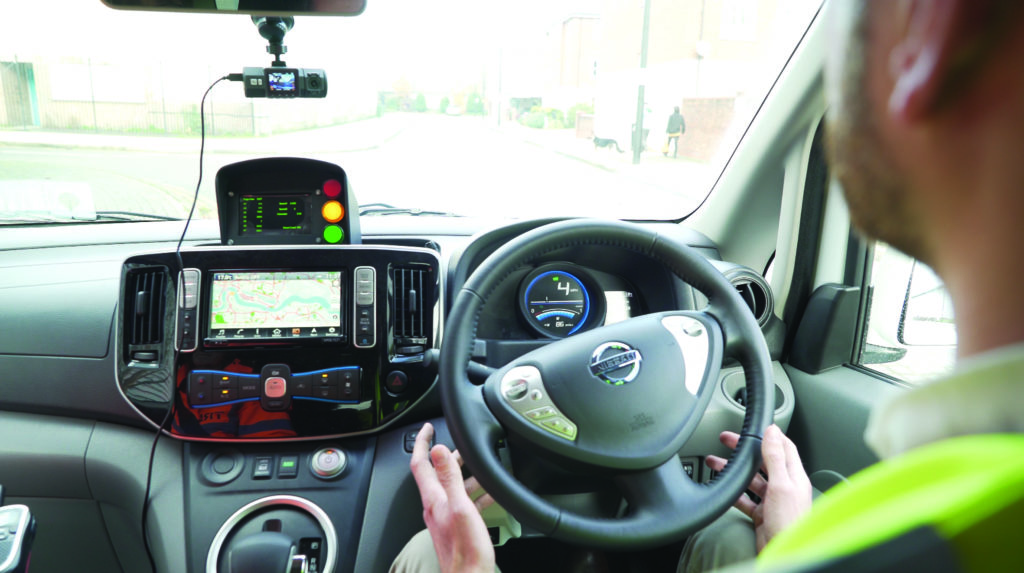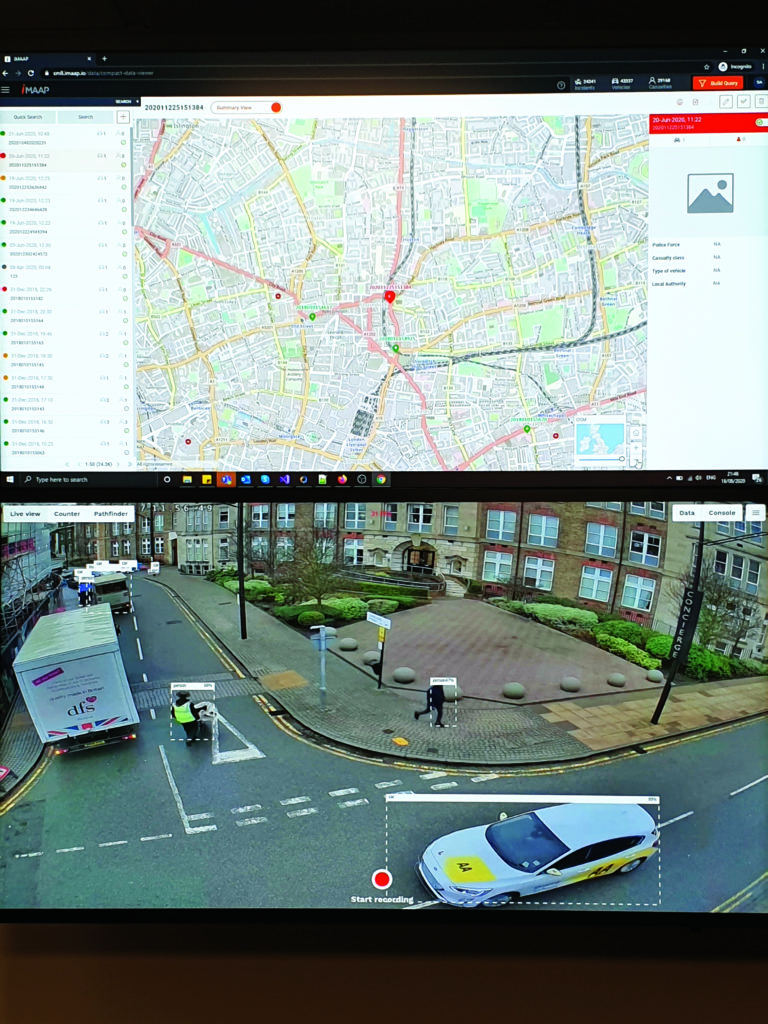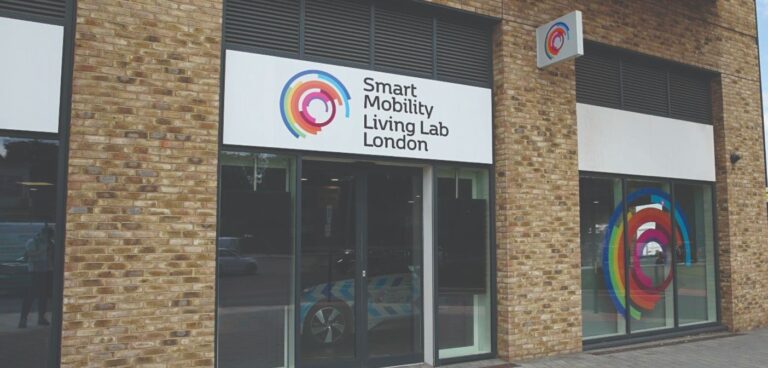Katie Searles tours London’s Smart Mobility Living Lab, a £20m test facility designed to help businesses and public sector organisations commercialise connected and autonomous vehicle solutions faster than ever before…
At the end of September London’s Smart Mobility Living Lab (SMLL) officially opened its doors in Woolwich, within the Royal Borough of Greenwich, providing companies with an opportunity to test and validate connected and autonomous vehicles (CAVs), new mobility technologies and services in real-world conditions.
A collaboration between TRL, Cisco, DG Cities, London Legacy Development Corporation, Cubic, Loughborough University and Transport for London, the new facility represents a £20m investment by government and industry.
Upon entering the site, visitors initially step into an indoor workshop built for making adjustments to CAVs that use the testbed. The workshop can fit up to five vehicles but has three work bays and four Schnedier 22kW smart charge points, as well as an ultra-fast EV charger in the basement.
Two fully electric autonomous-ready Nissan e-EV200s, each with vehicle-to-grid and vehicle-to-infrastructure capabilities, are available to test. According to TRL project manager, Tom Tompkin, the CAVs, which feature StreetDrone technology, operate on an open-architecture platform, enabling customers to deploy them in both research and service delivery, using any type of CAV technology or CAV connectivity with infrastructure.

Both test vehicles include a roof rack that customers can add additional sensors or cameras to. A lidar laser light scanner can also be attached to provide 360-degree mapping of the testbed. The technology provides such a detailed image that it was recently used by police forces for road accident mapping. “By taking a scan of the area, roads can be reopened quicker as the lidar radar images include all the necessary details, from kerb height and obstruction size to even skid mark length,” explains Tompkin.
As the testbed is designed for companies to bring their own CAVs or associated technologies for development, there are no plans to expand the size of the SMLL fleet.
Data-driven insights
Beyond the workshop, the SMLL opens up into a shared workspace, event area, private offices and ethernet-connected control room and data centre. It is into the data centre that information from the SMLL’s 24km (15-mile) testbed, which features 196 lampposts fitted with 276 CCTV cameras, feeds back into.
From the control room, companies can monitor real-time footage of the testbed from the Woolwich HQ to an off-road testing ground at east London’s Queen Elizabeth Olympic Park. Real-world data is clearly presented using visual analytics. “It’s designed to be a collaboration environment, allowing customers to exchange or import data and access wider mobility data sets,” says Lucian Linders, general manager of SMLL.
A short walk to a car park behind the Woolwich hub reveals one the site’s 196 lampposts equipped with a range of Cisco cameras and one of 34 cabinets, which feeds the private fibre network back to the control centre. According to Linders, the site has been futureproofed, with the posts able to accommodate more advanced cameras. When asked about 5G capability, Linders explains that the SMLL has already established a partnership for the wider 5G network roll out.
In total, the test site has over 1,000 road features including roundabouts, islands and parked vehicles. Residential commuter streets offer up a variety of scenarios for trialling CAVs, making it one of the few places in the UK where tests can take place on real roads. And while a 5mph speed limit has been set by the Royal Borough of Greenwich, Linders says it’s hoped the SMLL will eventually be able to trial vehicles on routes at a slightly higher speed.
Test drives are currently performed and overseen by safety steward Adam Gristock, safety driver Fionán O’Sullivan and engineer Abdelrahman Barghout, who together complete a series of loops of a section of the testbed that covers both an industrial estate and residential housing.

The two test vehicles are currently able to navigate corners and accelerate over speed bumps, with the safety driver able to regain control for “dynamic objects”, such as a pedestrian exiting a parked vehicle into the carriage or a van parked half on the kerb with commercial refuse receptacles on the opposite side of the road.
Sim city
To safely test a CAV’s interaction with other roads users the facility has a digital twin simulator, which takes real-world data, such as pedestrian and cyclist behaviour, and turns it into an ultra-realistic virtual world for CAVs to be trialled. There is also a virtual reality headset for human factor tests. SMLL has partnered with UK-based driving simulation company rFpro to improve the technology.
According to rFpro, its software will further develop the fidelity of the simulated environment, with enhanced features such as a vehicle dynamics grade road surface, accurate material definitions and increased accuracy virtual sensor models.
TRL academy director, Richard Cuerden, believes the use of simulated scenarios featuring real-world incident data will enable the SMLL to support the full testing cycle, with simulation testing including not only the vehicle’s reaction to the physical road layout and surface but also scenarios generated from interactions with pedestrians, buses, cyclists and other traffic.
“Simulation is a critical part of the vehicle development process and is key to getting CAVs on to our roads safely,” Cuerden says. “The SMLL is already one of the world’s most advanced urban test facilities for CAVs but we believe the addition of rFpro’s advanced digital twin will offer significant additional value to our customers.”

It’s precisely this combination of real-world test roads, autonomous ready vehicles and digital simulator that the SMLL believes will help businesses and public sector organisations make future mobility a safe and commercial reality sooner rather than later.
Linder explains: “SMLL exists to encourage the key players in the automated vehicle technology industry to come to London to develop and prove their concepts. At SMLL they can take advantage of our unique offering of simulating the performance of their product and then testing in the real world to demonstrate that what works in the complex on-road environment of London will work safely anywhere.
“Our ambition is to enable a broad field of agile innovators to rapidly develop their services and products, with the goal of introducing commercial solutions faster, and bring the benefits of safety and accessibility of new modes of transport to our communities.”
Integrated approach
One of the first customer projects to take place at the SMLL’s new test facility in Woolwich is ServCity, a 30-month autonomous mobility service research programme looking to overcome barriers currently hindering the deployment of autonomous vehicles in UK cities.Jointly funded by industry and the UK government’s £100m Intelligent Mobility fund – which is administered by the Centre for Connected and Autonomous Vehicles and delivered by Innovate UK – ServCity comprises six partners; Nissan, Connected Places Catapult, TRL, Hitachi, SBD Automotive and the University of Nottingham.
Through a combination of test simulation, end-user experience research and real-world trials, ServCity will concentrate on three key areas – technology, people and scalability – to ensure an intuitive, inclusive and engaging user experience. Nissan will provide its battery-electric Leaf for the project, with initial tests conducted at the SMLL facility prior to public road testing in the UK capital city.
Lucien Linders, general manager of SMLL, says: “Through using the infrastructure and monitoring facilities at our Smart Mobility Living Lab in London, we are uniquely placed to analyse the performance and benefits of automated mobility services in a complex city environment. We are proud to be offering our expertise to this ground-breaking project.”
Of the other partners, Hitachi has been tasked with developing technology for predicting and safely responding to moving objects; the University of Nottingham’s Human Factors Research Group will generate theories, models and methods behind the user experience of vehicle occupants; and SBD Automotive, a consultancy firm specialising in automotive technologies, will help to define and test different approaches to delivering “a seamless automated driving experience”.
ServCity also leverages the experience and expertise acquired though the HumanDrive project, which evaluated autonomous driving on countryside and motorway lanes, overcoming challenges such as roundabouts and high-speed country lanes with no marking, white lines, or kerbs.
That project, which also used a Nissan Leaf, was completed in February with Grand Drive, reportedly the UK’s longest and most complex autonomous drive, from Cranfield to Sunderland. It’s believed that data and learning gathered during HumanDrive will help in the completion of the new venture.
This article originally appeared in the November 2020 issue of CiTTi Magazine





